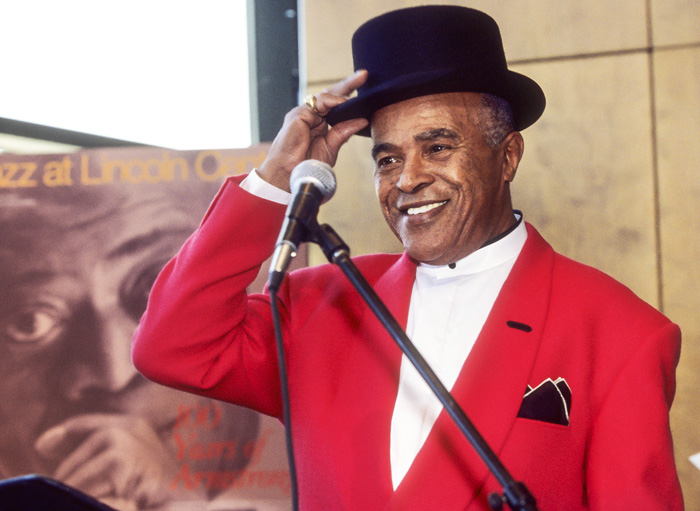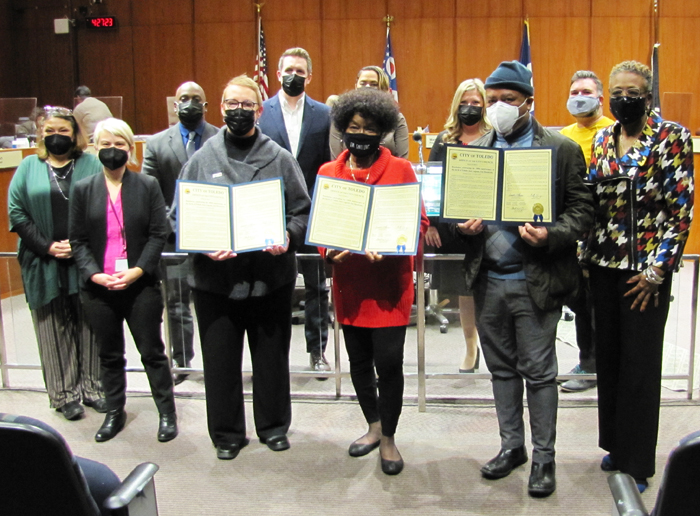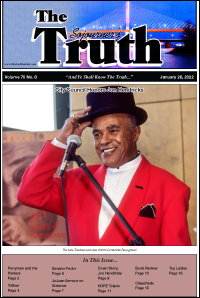
Sojourner’s Truth Staff
“We so seldom recognize and honor the strong history we have in Toledo,” said Councilwoman Cerssandra McPherson last week during a City Council meeting which, at the councilwoman’s urging, did just that – recognized and honored one of Toledo’s own – Jon Hendricks.
Hendricks, a jazz artist extraordinaire and of worldwide fame and acclamation, died in 2017 but would have celebrated his 100th birthday in September 2021. Toledo City Council, along with the Toledo Jazz Society, represented at the Council meeting by Ramona Collins, Kim Buehler and Brett Collins, expressed their gratitude for the many years of pleasure Hendricks brought to millions.
“WHEREAS, Jon Hendricks, a legend in the jazz world who taught at The University of Toledo 16 years, died November 22, 2017 at age 96 in New York City,” read the opening of the proclamation.
Hendricks and his family, including 14 siblings, moved to Toledo when he was young and he began singing at the age of seven.
“By the time I was 10, I was a local celebrity in Toledo,” he once said. “I had offers to go with Fats Waller when I was 12 and offers to go with Ted Lewis and be his shadow when I was 13.”
Hendricks and his family lived on the same street as Art Tatum and he received early musical training from the master pianist, appearing with him around town.
“WHEREAS, at age 14 Jon Hendricks started performing at the Waiters and Bellmen’s Club on Indiana Avenue in Toledo, of which he recalled, ‘I met a lot of people at 14 – Louis Armstrong, Count Basie, Lucky Millinder, Andy Kirk, Don Redman. I met just about anybody that there was because everybody came to hear Art Tatum.’”
Hendricks served in World War II and took part in the D-Day landings of June 6, 1944 returning to Toledo after the war and attended the University of Toledo on the G.I. Bill until the benefits ran out. On an occasion when Charlie “Bird” Parker was performing in Toledo, Hendricks joined the band to scat. His performance so impressed Bird that the saxophonist encouraged him to head to New York.
During the 1950s, Hendricks wrote music for Louis Jordan, recorded with King Pleasure and eventually teamed with Dave Lambert and Annie Ross to form Lambert, Hendricks and Ross perfecting the art of “vocalese.” The group would record six albums, garner lots of honors and awards and sell scads of albums. Hendricks Was frequently the lyricist for their songs.
In the 1960s, Hendricks began his solo career.

“WHEREAS, as a solo artist, Jon Hendricks continued to gain attention behind the microphone with his early recordings including ‘Bossa Man’ (1963), ‘Salud!’ (1964) and ‘Watermelon Man’ (1965), and also sang with the Count Basie Band from 1959 to 1965 and with Duke Ellington from 1965 to 1974; finally, another collaboration found Hendricks recording a song with the Grateful Dead in 1966.”
In 1968, Hendricks altered course – the course of his professional career and his personal life – and moved his family to London, England where they would live for the next five years. Hendricks performed extensively in Europe and Africa while continually writing music and recording albums.
After his London stint. Hendricks returned to the U.S. settling in the San Francisco area and writing as the jazz critic for the San Francisco Chronicle and teaching classes at California State University at Sonoma and the University of California at Berkeley.
“WHEREAS, while always in demand as a singer, Jon Hendricks never got far away from his way with words and, over the years, he penned lyrics for music written by Ellington, Miles Davis, Sonny Rollins and Antonio Carlos Jobin. Thelonious Monk wouldn’t have anyone else but Hendricks write words for his songs.”
Hendricks worked with his friends in the Manhattan Transfer in 1985 on their album, Vocalese, served on the Kennedy Center Honor Committee under presidents Carter, Reagan,= and Clinton and cut a final studio album in 1990, Freddie Freeloader, which was Grammy nominated and featured a line-up of artists George Benson, Al Jarreau, Bobby McFerrin, Tommy Flanagan, Jimmy Cobb, Larry Goldings, Wynton Marsalis, Stanley Turrentine, Al Grey, the Manhattan Transfer and the Count Basie Orchestra.
Finally, in 200, Hendricks returned to his hometown to teach at The University of Toledo and was appointed Distinguished Professor of Jazz Studies, receiving an honorary doctorate in the Performing Arts. He was also selected as the first American jazz artist to lecture at the Sorbonne in Paris.
His University of Toledo15-voice group, the Jon Hendricks Vocalstra, performed at the Sorbonne in 2002 and Hendricks continued to write lyrics to jazz as well as classical pieces.
As recently as 2016, he appeared on several albums. In 2017, the jazz vocalist died at the age of 96.
“WHEREAS, through the years, Jon Hendricks received numerous awards, including, in 1992, he was the recipient of the highest honor given to a jazz artist – the National Endowment for the Arts American Jazz Masters Fellowship; in 2004 he was given a French Legion of Honor in the class of knight – France’s highest civilian commendation and the Satchmo Award for his lifetime commitment to jazz.”
“It was such an honor for me to be invited back to my hometown to teach what I do,” he once said in an interview for “The University of Toledo Alumni Who Have Changed the World.”

